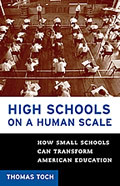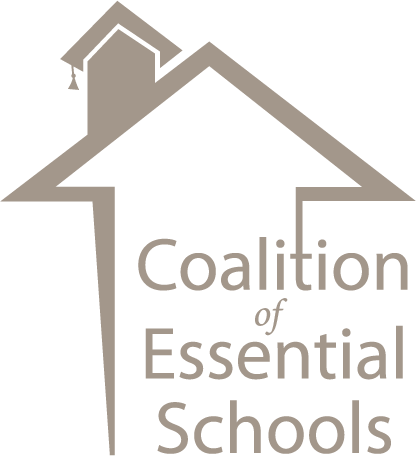 By Thomas Toch (Beacon Press, 144 pages, $15.00)
By Thomas Toch (Beacon Press, 144 pages, $15.00)
reviewed by Laura Flaxman
“The prospect of high schools on a more human scale ultimately requires a belief on the part of educators and policy-makers that the necessary changes to the status quo needed to create such high schools are worth the hard work needed to achieve them. The stories of the students and educators at Urban Academy, The Met, New Country, Julia Richman, and High Tech High suggest emphatically that they are.”
I highly recommend Thomas Toch’s High Schools on a Human Scale, which makes a compelling case for new, innovative small schools while also providing specific examples from which to learn. High Schools on a Human Scale contains a wealth of examples and ideas from some of the most innovative small schools in the country. With a persuasive foreword by Thomas Vander Ark of the Bill and Melinda Gates Foundation and an instructive introduction detailing the history of our nation’s public high schools, High Schools on a Human Scale is of interest to practitioners undertaking high school restructuring and the creation of small schools. Toch’s skill as a journalist makes each school, with its successes and challenges, come alive.
The first chapter, about New York City’s Julia Richman Education Complex, is a must-read for anyone grappling with transforming or reconstituting a large high school. Details about the Complex’s inner, logistical workings offer ways to avoid pitfalls that can recreate many of the same conditions that compel traditional large schools to take on the work of transforming themselves into small schools in the first place. The Julia Richman Education Complex, formerly a large, traditional and dysfunctional high school, has been inventing and perfecting a new way of creating and growing excellent schools that share and maximize the spaces built for a very different, increasingly obsolete public high school model.
For educators and faculties interested in moving towards inquiry-centered teaching, the chapter on Urban Academy, a school within the Julia Richman Education Complex, would make a great text for a study group. Toch takes you into the school and gives you a good sense of the culture, philosophy and classrooms in a relatively limited number of well-written pages. One gets the sense of both the struggles and the promise of approaching teaching from this foundation of inquiry, with student thought and discourse strongly at the center.
High Tech High in San Diego, California is the subject of the third chapter. Although it shares some priorities with Urban Academy, particularly in terms of trying to build a program around student inquiry, it is exciting to see an example of another innovative small school that takes a completely different approach to schooling. As a former principal of a theme-based school, I found this chapter particularly instructive in thinking through the use of a thematic lens in designing a school. High Tech High’s physical layout and nontraditional use of instructional time encourage readers to think creatively in designing other programs.
The Met, in Providence, truly pushes the envelope when it comes to using the real world as a classroom. Anyone interested in school-to-work programs and the central role that meaningful student internships can play in education would be interested in Toch’s portrayal of this highly individualized school. The history, successes and challenges of the Met are presented in a way that is instructive to anyone interested in seriously overhauling the way we do high school education, but without sugar-coating. For example, that all Met students master common content area skills through their widely varied internships continues to be a challenge, particularly when it comes to math.
Minnesota New Country School in rural Minnesota is an experiment in teacher leadership and a co-operative form of school management. The premise is that substantive autonomy for every aspect of a school’s program and operations makes for a highly professional, involved faculty and a superior school. Teachers are co-owners in the EdVisions co-op that operates Minnesota New Country School’s charter and therefore they have a significant stake in the details of the school’s management from student enrollment and attendance to fiscal responsibility. Teachers hire and evaluate other teachers without the constraints of tenure, seniority or other controls typically maintained by school boards and unions. In an example recounted in the chapter, a teacher who does not have enough students choosing his or her advisory, or who in other ways does not meet performance standards set by the school, can be terminated. Compared to the other examples in the book, I am struck by the limited focus on instruction and classroom practice in the chapter, if not the school. However, for those interested in exploring models of teacher-led schools, this piece would be a good starting point.
Any educator, policy-maker, or student of education could gain tremendously by reading this book. These schools and their stories provide a cornucopia of brilliant ideas and inventions ripe for further study and experimentation. As a school practitioner, it brings out all of my best teacher-as-thief impulses; for policy-makers, the implications for decentralization and site-based autonomy are critical; for researchers, there are clearly some groundbreaking new ideas being piloted and begging to be studied further. Very readable and informative, High Schools on a Human Scale is a must-read for anyone involved in high school reform on any level.
Laura Flaxman has recently joined CES as a Director of New & Mentor Schools. Most recently, Laura founded and served as principal of Life Academy of Health & Bioscience, a new small public high school in Oakland, California.
